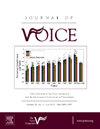What are the Symptoms that Characterize the Clinical Condition of Vocal Fatigue? A Scoping Review and Meta-Analysis
IF 2.5
4区 医学
Q1 AUDIOLOGY & SPEECH-LANGUAGE PATHOLOGY
引用次数: 0
Abstract
Introduction
Vocal fatigue is a clinical manifestation associated with a perception of negative vocal adjustment. It is related to the increase in the sensation of excessive effort when speaking and the lack of conditioning of the muscles and structures that involve vocal production. Because it has a complex and multifactorial diagnosis, there is still no consensus on the symptoms most commonly found in this clinical condition.
Objective
To review and analyze the symptoms that characterize the clinical condition of vocal fatigue.
Methods
This study consists of a scoping review carried out in the Cochrane Library, Embase, Lilacs, and Medline databases. Observational studies or clinical trials from the last 10 years. Studies with participants younger than 18 years of age were excluded; as well as research that did not describe symptoms of vocal fatigue or that presented vocal fatigue as a symptom; studies with patients with neurological, psychiatric, syndromic conditions, or head and neck cancer. The Quality Assessment Tool for Observational Cohort and Cross-Sectional Studies NHLBI-NIH scale was used to assess the methodological quality of selected observational studies and the PEDro scale for the analysis of experimental studies. The steps were performed by three blinded evaluators. Subsequently, meta-analyses of global means were executed for each factor under study; a comparison of the difference in the mean score for each factor between exposed and unexposed; a comparison of the difference in the average score, among non-professional voice users, for each factor between exposed and unexposed.
Results
In the searches performed, 956 articles were found and 29 articles were selected according to the eligibility criteria. Of these, 93.11% of the studies were observational and 6.89% were clinical trials. Regarding the gender and age group of the study samples, women aged between 30 and 45 years were predominant. As for the occupational use of voice, 68.97% of the samples were composed of professional voice users and 31.03% of non-professional voice users, with most professional voice users being teachers and non-professional voice users, individuals with dysphonia or vocal complaint. To assess vocal fatigue symptoms, 28 studies used the Vocal Fatigue Index (VFI) protocol, and only one study used another assessment protocol, Self-Administered Voice Rating. All studies were classified as regular, according to the scale used. As for the meta-analyses performed, the mean scores of the VFI factors were higher among professional voice users when compared to non-professional voice users and higher in dysphonic individuals compared to non-dysphonic individuals.
Conclusion
The vocal fatigue symptoms found in this review were common in the populations of professional voice users and non-professional voice users and dysphonic and non-dysphonic individuals. These symptoms were related to vocal recovery after rest, physical discomfort, and restricted vocal use.
声带疲劳临床症状的特征是什么?范围审查和元分析。
简介声带疲劳是一种临床表现,与声带调节不良的感觉有关。它与说话时过度用力的感觉增加以及发声肌肉和结构缺乏调节有关。由于该病的诊断复杂且涉及多种因素,目前对该病最常见的症状仍未达成共识:回顾并分析声带疲劳临床症状:本研究包括在 Cochrane 图书馆、Embase、Lilacs 和 Medline 数据库中进行的范围审查。过去 10 年中的观察性研究或临床试验。不包括参与研究者年龄小于 18 岁的研究;不包括未描述发声疲劳症状或将发声疲劳作为一种症状的研究;不包括涉及神经、精神、综合症或头颈部癌症患者的研究。观察性队列和横断面研究质量评估工具 NHLBI-NIH 量表用于评估选定观察性研究的方法学质量,PEDro 量表用于分析实验性研究。这些步骤由三名盲人评估员完成。随后,对所研究的每个因素进行了总体平均值荟萃分析;比较了暴露与未暴露的每个因素的平均得分差异;比较了暴露与未暴露的每个因素在非专业语音用户中的平均得分差异:在所进行的搜索中,共找到 956 篇文章,根据资格标准筛选出 29 篇文章。其中,93.11%的研究为观察性研究,6.89%为临床试验。在研究样本的性别和年龄组别方面,30 至 45 岁的女性居多。在嗓音的职业用途方面,68.97%的样本为专业嗓音使用者,31.03%为非专业嗓音使用者,其中专业嗓音使用者多为教师,非专业嗓音使用者多为发音障碍或嗓音不适者。为了评估发声疲劳症状,28 项研究使用了发声疲劳指数(VFI)方案,只有一项研究使用了另一种评估方案,即自控嗓音评分。根据所使用的量表,所有研究都被归类为常规研究。在所做的荟萃分析中,专业嗓音使用者的 VFI 各因子平均得分高于非专业嗓音使用者,发音障碍者的 VFI 各因子平均得分高于非发音障碍者:本研究中发现的发声疲劳症状在专业用嗓者和非专业用嗓者、发音障碍者和非发音障碍者中都很常见。这些症状与休息后的发声恢复、身体不适和发声受限有关。
本文章由计算机程序翻译,如有差异,请以英文原文为准。
求助全文
约1分钟内获得全文
求助全文
来源期刊

Journal of Voice
医学-耳鼻喉科学
CiteScore
4.00
自引率
13.60%
发文量
395
审稿时长
59 days
期刊介绍:
The Journal of Voice is widely regarded as the world''s premiere journal for voice medicine and research. This peer-reviewed publication is listed in Index Medicus and is indexed by the Institute for Scientific Information. The journal contains articles written by experts throughout the world on all topics in voice sciences, voice medicine and surgery, and speech-language pathologists'' management of voice-related problems. The journal includes clinical articles, clinical research, and laboratory research. Members of the Foundation receive the journal as a benefit of membership.
 求助内容:
求助内容: 应助结果提醒方式:
应助结果提醒方式:


